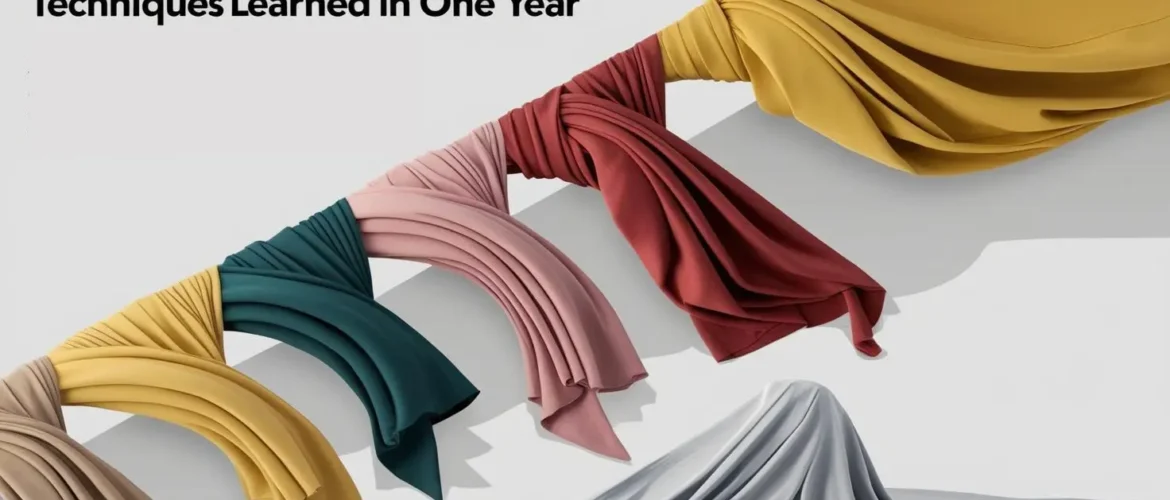Blog
Mastering Fabric Draping Techniques in Fashion Design: A 1-Year Learning Plan by Maya’s School of Designs
- February 11, 2025
- Posted by: admin
- Category: Fashion Design

Fabric draping is one of the most exciting and creative aspects of https://mayaschoolofdesigns.com/fashion design. To take a flat piece of fabric and turn it into a beautiful 3D garment is both an art and science, requiring a great degree of patience, experimentation, and deep understanding of materials.
At Maya’s School of Designs, the experts firmly believe that the learning of fabric draping techniques does not just hone your skills but actually transforms your whole design approach. Be it a beginner or an aspiring designer, this systematically developed one-year course plan will help you build confidence, creativity, and technical mastery in draping.
Why Should You Learn Fabric Draping Techniques?
Draping is far more than just placing fabric on a mannequin; it’s about giving life to your imagination. The technique allows designers to visualize ideas directly on the dress form, creating organic shapes that patterns on paper simply can’t capture.
A 2024 study by IFAI found that over 68% of professional fashion designers consider draping to be one of the top three most important skills in the creation of original collections.
Here’s why learning draping techniques is a must for every fashion student:
Design freedom: Draping opens up endless creative possibilities because you are not restricted by flat patterns; your fabric becomes your canvas.
Better Fit: Draping lets you understand how fabric interacts with the human body, helping you achieve the perfect silhouette.
Personal Style: You will develop a unique creative signature that reflects your artistic vision and personality.
Can You Master Fabric Draping in One Year?
Absolutely! If the person continuously practices and gets structured learning about fabric draping, then one year is enough to master the fundamentals of the subject. This may be done by following a progressive plan: mastering the basics, exploring silhouettes, and experimenting with advanced techniques month by month.
Let’s break down the year-long journey:
Months 1–3: Laying the Foundation
The first three months should be about mastering the basics of draping and getting acquainted with your tools.
You’ll need:
A dress form or adjustable mannequin
Draping fabrics (muslin or cotton)
Pins, chalk and measuring tape
Start by creating simple shapes like bodices, skirts, and tops. Observe how fabric behaves when pinned and folded. Take the time to understand grainlines, tension, and flow.
In Month 3, you should be able to confidently make a basic drape and develop an understanding of how fabric goes from flat to fitted.
Pro Tip: Practice with different fabrics — cotton, linen, or chiffon — every day to develop your intuition about drape and texture.
Months 4–6: Exploring Silhouettes and Structure
Work with asymmetrical patterns, layering fabrics, and experimental folds. Combine draping, pattern making, and sewing to create ready-for-production garments.
This stage is where creativity meets precision. You’ll begin to see your draping go from being just class exercises into real wearable art.
By Month 9, you’ll have a collection of advanced draped pieces that reflect technical mastery and creative flair.
???? Pro Tip: Document your work. Take photos, make sketches, and note down what works — this builds a strong portfolio for future opportunities.
Months 10-12: From Draping to Ready-to-Wear Mastery
In the final stretch, it’s about perfecting your couture-level draping skills and translating them into finished garments.
Emphasize precision, proportion, and polish. Study high-fashion draping techniques from designers around the world: how they balance elegance, structure, and fluidity.
In Maya’s School of Designs, at this stage, the students often create their final design collections comprising couture-inspired gowns and ready-to-wear ensembles that highlight advanced craftsmanship.
By the end of the year, you will have a complete draping portfolio that shows your evolution from basic forms to professional-level designs.
???? Reflect and Refine: Review your progress and seek feedback from mentors or peers to refine your creative voice and technical approach.
Conclusion
Mastering fabric draping techniques is not only about making clothes but also about instinctively perceiving design, fabric behavior, and aesthetic harmony.
This one-year journey is just the beginning. Keep exploring through fashion workshops, internships, and industry events. The best designers are those who learn throughout their lives-they continue experimenting, innovating, and pushing the boundaries of creativity.
At Maya’s School of Designs, the philosophy on which our programs in fashion design are harnessed includes combining creativity with technical training and hands-on industry experience to shape the next generation of visionary designers.
FAQ — Fabric Draping Techniques in Fashion Design
Q1. What is fabric draping in fashion design?
Fabric draping is the process of arranging fabric on a dress form or mannequin to visualize and create a garment’s design, shape, and fit.
Q2. Can I learn fabric draping without prior fashion experience?
Yes, it can! Guided training and regular practice will enable a novice to easily learn the basics of draping within a few months.
Q3. How long does it take to master draping techniques? A structured one-year plan, such as the one followed at Maya’s School of Designs, is ideal for acquiring professional-level skills. Q4. What fabrics are best for beginners? Muslin and cotton are great starting points for novices, considering their stability and ease of handling. Q5. How can fabric draping help my fashion career? Draping enhances your ability to design original silhouettes, improves your understanding of garment fit, and helps build a professional portfolio. Author Bio This article is provided by the Fashion Faculty Team at Maya’s School of Designs, a top fashion design institute in Bengaluru offering B.Des, Diploma, and Certification courses. The school empowers budding designers with practical knowledge, creative thinking, and real-world experience to build successful design careers.
